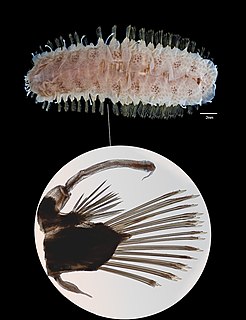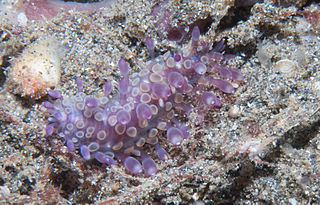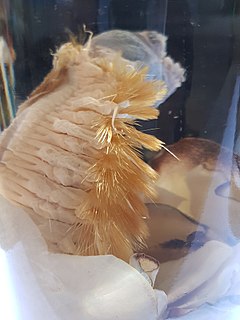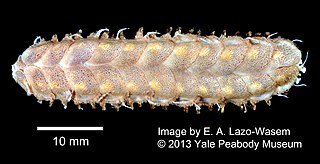
In invertebrates, the term parapodium refers to lateral outgrowths or protrusions from the body. Parapodia are predominantly found in annelids, where they are paired, un-jointed lateral outgrowths that bear the chaetae. In several groups of sea snails and sea slugs, 'parapodium' refers to lateral fleshy protrusions.

Polynoidae is a family of marine Polychaete worms known as "scale worms" due to the scale-like elytra on the dorsal surface. Almost 900 species are currently recognised belonging to 9 subfamilies and 167 genera. They are active hunters, but generally dwell in protected environments such as under stones. The group is widely distributed from shallow intertidal waters to hadal trenches. They are the most diverse group of polychaetes in terms of genus number and second most diverse in terms of species number which is almost 8% of all segmented worm species.
Adyte assimilis is a marine polychaete scale worm in the family Polynoidae.

Phyllodocida is an order of polychaete worms in the subclass Aciculata. These worms are mostly marine though some are found in brackish water. Most are active benthic creatures, moving over the surface or burrowing in sediments, or living in cracks and crevices in bedrock. A few construct tubes in which they live and some are pelagic, swimming through the water column. There are estimated to be about 3,500 species in the order.
Adyte is a genus of marine annelids in the family Polynoidae. The genus includes a single species found in the North-east Atlantic Ocean and Mediterranean Sea, at depths down to about 150 metres.
Erinaceusyllis cirripapillata is a species belonging to the phylum Annelida, a group known as the segmented worms. E. cirripapillata is characterized by its papillae on its dorsal cirri, one of them being distinctively mushroom-shaped. No species of this genus or Sphaerosyllisis is known to possess this particular kind of papillae. The name of the species refers to these same papillae.
Sphaerosyllis voluntariorum is a species belonging to the phylum Annelida, a group known as the segmented worms. This species is closely related to Sphaerosyllis bifurcata, Sphaerosyllis bifurcatoides and Sphaerosyllis rotundipapillata, all endemic species to Australia, characterized by having large dorsal papillae, sometimes trilobed, and with shafts of compound chaetae distally bifid. S. voluntariorum is more densely papillated on its anterior segments and has a long subdistal spine on the ventral simple chaetae. This species' name alludes to the volunteers of the Marine Invertebrate section of The Australian Museum, who sorted specimens of syllids that led to the description of this animal.
Arctonoe is a genus belonging to the family Polynoidae, worms commonly known as "scale worms". Members of this genus predominantly occur in shallow waters of the North-east Pacific Ocean and often live as commensals of other marine invertebrates, frequently echinoderms but sometimes molluscs or other polychaetes.

Eulagisca gigantea, a giant polynoid worm also known as an Antarctic scale worm, is a species of marine polychaete worm belonging to the family Polynoidae, the scale worms. This species is found on the seabed in the Southern Ocean.

Leucia nivea is a species of polychaete worm, commonly known as a "scale worm", in the family Polynoidae. This species occurs in the northeastern Atlantic Ocean, the North Sea and the Mediterranean Sea.
Leucia violacea is a species of polychaete worm, commonly known as a "scale worm", in the family Polynoidae. This species occurs in the northeastern Atlantic Ocean.
Eunoe is a genus of marine annelids in the family Polynoidae. The genus includes 48 species which are found world-wide, mostly from depths of 50 m or more.

Eunoe leiotentaculata is a scale worm known from southern Australia and New Zealand and the South Pacific Ocean at depths of 500-1200 m.

Phyllodoce lineata is a species of polychaete worm in the family Phyllodocidae. It is native to the northeastern Atlantic Ocean and the Mediterranean Sea where it occurs in the intertidal and shallow sub-tidal zones on soft sediment.
Acholoe is a genus of marine annelids in the family Polynoidae. The genus was described in 1870 and includes a single long-bodied species with 100 or more segments and which occurs in the Mediterranean Sea and North-east Atlantic Ocean.
Acanthicolepis is a genus of marine annelids in the family Polynoidae. The genus was described in 1990 and includes two short-bodied species with up to 50 segments and which occur in the Mediterranean Sea and North-east Atlantic Ocean.
Augenerilepidonotus is a genus of marine annelids in the family Polynoidae. The genus includes a single species which is known from Australia, usually from depths of about 40 metres or less..

Lepidonotus is a genus of marine annelids in the family Polynoidae. The genus occurs globally and includes 80 species, usually found in shallow waters down to about 80 metres.
Adyte hyalina is a species of marine annelids in the family Polynoidae ; it is the single recognised species in the genus Adyte and occurs in the North-east Atlantic Ocean and Mediterranean Sea, at depths down to nearly 300 metres
Australaugeneria is a genus of marine annelids in the family Polynoidae. The genus includes 4 species which are commensal on octocorals.








